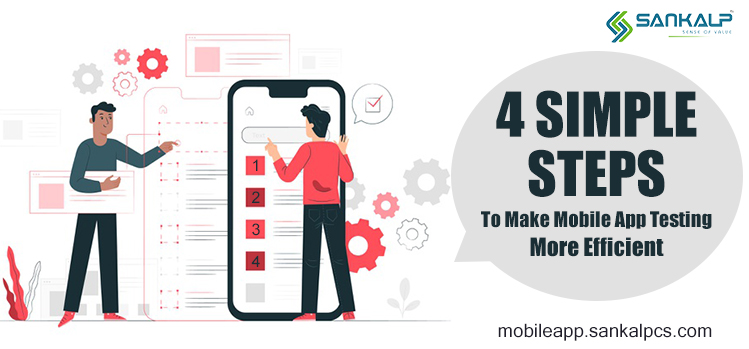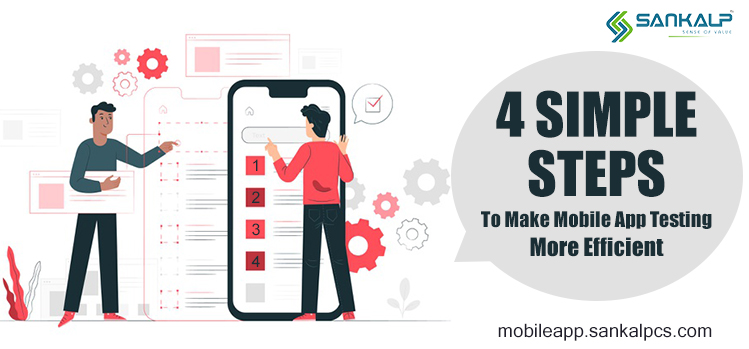With billions of smartphone users globally, it has never been more critical to check mobile applications as quickly and efficiently as possible.

Over 80% of our mobile use time goes into talking to apps, literally. And by “our,” we mean 5 billion smartphone users everywhere on the planet. To mobile app development companies, this might sound overwhelming and frightening simultaneously.
The competition is intense, and the user demands are very high. As a mobile app company, what do you do? Make sure to test it vigorously so that the final app is flawless.
Mobile app testing is often a chore, but it doesn’t need to. Here are Simple Steps to Make Mobile App Testing More Efficient.
1. Plan and stick to them
Just as you’re planning the workflow and sprints of your mobile development team, you should have an idea for the mobile app testing process and, most significantly, stick with it. As test cycles get shorter, you won’t have the time to ponder about the kinds and methods you’re getting to use halfway through the journey.
So, confirm to work out beforehand:
- If you’re going for manual or automated testing
- What testing types you’re getting to perform
- If you’re getting to use a cloud-based mobile app testing solution
- What methodology you’re getting to stick with
- If you’d got to allocate more testers
- What the performance criteria are going to be
- Whether you’re getting to use emulators or physical devices
- What your KPIs are going to be
These are some basic questions managers should know answers to before the QA team starts performing on a project. Contribute a bunch of your project-specific questions, and you’ve got yourself a roadmap that will make testing faster and more efficient.
2. Continuous testing is the need of the day
According to Instabug’s research, most apps release builds weekly, followed by bi-weekly releases then monthly. This shows that mobile app development companies and teams are eagerly embracing continuous integration and continuous deployment. But if you would like to emphasise even more efficiency to the method, you ought to implement continuous testing. It means running automated tests regularly to get instant feedback on the risks a release version might pose. And here’s why continuous testing is so important.
Mobile teams have learned to figure out shorter delivery cycles; therefore, the principles of lean software development are helping them achieve it. But testing is usually a bottleneck that slows down the acceleration the team was going for. Traditional manual testing can’t continue with the pace dictated by the exploding mobile app market. On top of that, testing apps at the top of iterations increases the value of every failure.
3. Use automated app testing
Mobile app test automation may have pros and cons, but it certainly helps when it involves increasing efficiency. Especially if you’re performing on a fast-growing application with short development cycles that often need running regression, performance, and compatibility tests.
Automated tests have innumerable advantages as they:
- are faster in test execution
- can be run more frequently
- reduce human error
- can be run on dozens of devices simultaneously
- can be scheduled at odd hours
With test automation, everyone wins! Testers can specialize in high-quality exploratory, security, or usability testing while tedious, repetitive, and time-consuming tasks are automated.
Automated tests can prevent time and money. But you furthermore may need to invest time and money in them before you begin reaping the advantages. Allow us to explain. Automation testing requires time for writing scripts and fixing environments. It also needs money investment since you’ve got to rent automated testers (or convert your manual testers into them) and buy a license for an automatic testing tool. But because of its speed, versatility, and continuity, automation pays off rich dividends.
Also Read: A Checklist To Assess Mobile App Developers For Your Next Project
4. Test with the Cloud
Cloud-based solutions and mobile testing may be a match made in digital heaven. Using the cloud as a testing environment where your mobile team can deploy and test mobile applications is useful for businesses of all shapes (general software development or mobile-only) and sizes (start-ups or enterprises).
With a reliable mobile device cloud, you’ll automate tests on many devices running on different platforms directly without having to take care of them physically. Cloud allows you to ditch managing server settings or licensing and cash in on its scalability and accessibility.
Final thoughts
If you feel that your mobile app’s standard assurance could use an efficiency boost, you’ve got several options to settle on. First, try drawing up an idea rather than testing intuitively, regardless of how more exciting or adventurous it’s going to sound. You’ve got to understand beforehand the testing methodologies, types, and tools your team goes to use if you would like reliable results.
Next, arm your CI/CD with continuous testing to eliminate the bottleneck that’s manual testing. It’s also a realistic idea to automate all the testing, which will be automated (exceptionally monotonous and time-consuming tasks), and test your mobile application within the cloud.
Looking for a renowned mobile app developer for your next app? Consider Sankalp.
Sankalp is arguably the top-notch mobile development company that has high customer ratings across different rating platforms for outstanding service delivery. Also, Sankalp is an ISO certified organization that recently received the Customer Choice Award 2019 by Software Suggest.
For your stunning, yet cost-effective mobile app, get in touch with Sankalp today:
Call: +91 9881748645
or email: sales@sankalpcs.com







Like!! Thank you for publishing this awesome article.